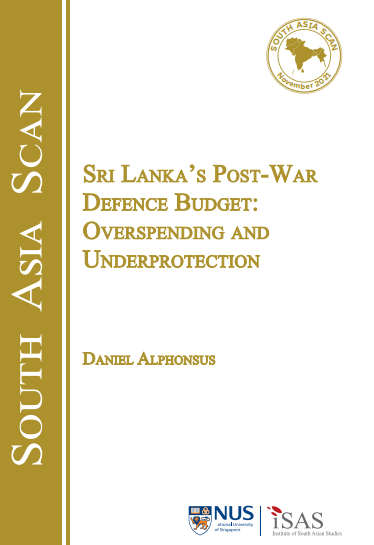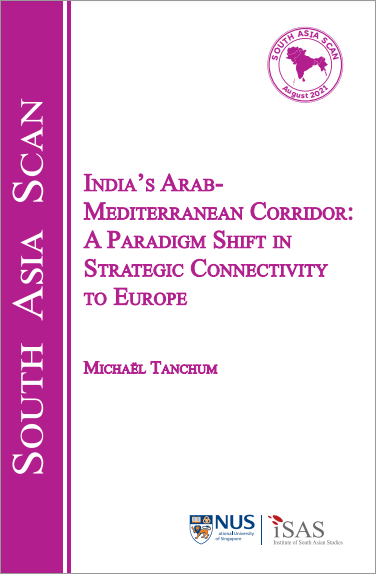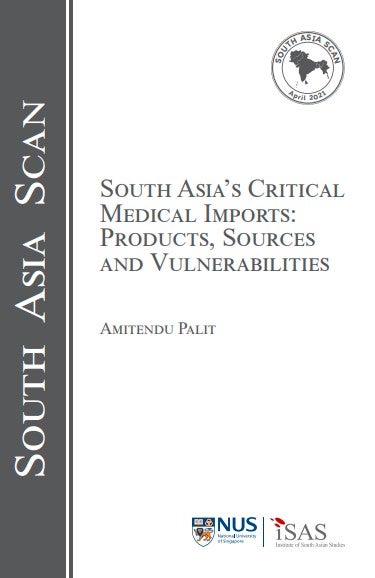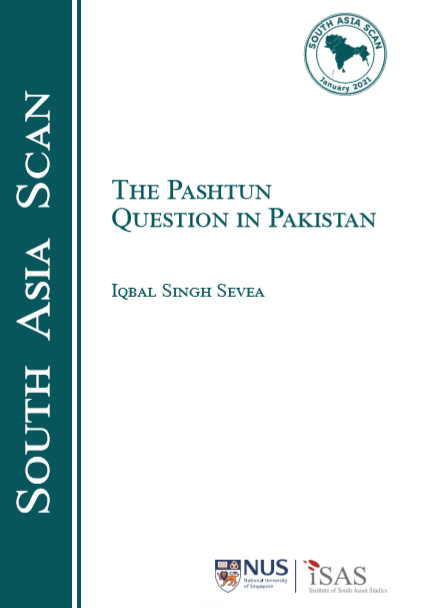
| Title: | Sri Lanka’s Post-War Defence Budget: Overspending and Underprotection |
| Author/s: | Daniel Alphonsus |
| Abstract: | Sri Lanka’s internal and external security environments have changed considerably in the last decade. Internally, a three-decade long civil war ended, but the country experienced the first wounds of Islamic terrorism – the Easter bombings. On the external front, as the unipolar world order’s zenith passed and its centre of gravity shifted towards Asia, Sri Lanka has become one of the foci of great power attention. However, despite this flux, there have been no major changes to the size or composition of Sri Lanka’s defence budget.
This South Asia Scan conducts the first-ever systematic review of Sri Lanka’s defence budget. The key findings are that Sri Lanka spends too much on defence and spends its defence budget inefficiently. The diagnostic and scenario-based methods used in this analysis estimate that Sri Lanka could enjoy a paradigm improvement in the level and quality of its security while bringing down its defence expenditure to below 1.5 per cent of its gross domestic product. This study also briefly discusses potential positive externalities arising from more rational spending, and offers an overview of its national security threats, problems with defence planning and recommendations for their resolution. |
| Date: | 18 November 2021 |
| DOI: | 10.48561/pbmh-fp3j |
| Read More |

| Title: | India’s Arab-Mediterranean Corridor: A Paradigm Shift in Strategic Connectivity to Europe |
| Author/s: | Michaël Tanchum |
| Abstract: | India’s Arabian-Mediterranean (Arab-Med) Corridor to Europe is an emerging multi-modal, commercial corridor that could radically reconfigure trade patterns between the Indian Ocean Region, the Middle East and Europe. For India, this new connectivity constitutes a strategic paradigm shift of enormous geopolitical consequence that could reshape its role in the Eurasian economic order.
The Scan explores the connectivity architecture that could result in an alternative trans-regional commercial transportation route, development of the multi billion-dollar ‘India-Middle East Food Corridor’, joining forces in petrochemicals manufacturing by integrating India’s hydrocarbon value chain and creating an innovation corridor for green energy and innovative technology manufacturing value chains. |
| Date: | 27 August 2021 |
| Read More |

| Title: | Myanmar’s Relations with China and India: The ASEAN Perspective |
| Author/s: | Sasiwan Chingchit |
| Abstract: | Myanmar has been a member of the Association of Southeast Asian Nations (ASEAN) since 1997. Being the only Southeast Asian country that shares land borders with two Asian giants, China and India, Myanmar’s trajectory is intimately shaped by their interests and actions.
This Scan looks at how ASEAN views Myanmar’s relationship with its two large neighbours and the extent to which its engagements with these two are in line with ASEAN’s interests. The analysis focuses on four main areas of engagement: economic development; Myanmar’s peace process with the ethnic armed organisations; the Rohingya crisis; and Myanmar’s democratic transition following the recent coup d’ét on 1 February 2021. |
| Date: | 22 July 2021 |
| Read More |

| Title: | Formalising the Quadrilateral: India’s Evolving Indo-Pacific Strategy |
| Author/s: | Vinay Kaura |
| Abstract: | India’s invitation to Australia to particiapte in the 2020 Malabar Naval Exercise amidst China’s continuing aggression in eastern Ladakh marked an important moment in the geopolitics of the Quadrilateral Security Dialogue (Quad) comprising India, the United States, Japan and Australia. The South Asia Scan argues that what has essentially encouraged India to become enthusiastic towards the revived Quad is the emergence of a militarised China threatening its territorial interests. It has recognised that the Quad’s formalisation is likely to have a deterrent effect on China.
This Scan recommends that the four countries should be proactive in making the Quad an institutionalised mechanism for Indo-Pacific security cooperation. One of its important agendas is to focus on preserving and protecting the democratic values of like-minded countries in the Indo-Pacific without interfering or allowing others to interfere in their domestic politics. |
| Date: | 28 May 2021 |
| DOI: | 10.48561/cerv-d6wt |
| Read More |

| Title: | South Asia’s Critical Medical Imports, Products, Sources and Vulnerabilities |
| Author/s: | Amitendu Palit |
| Abstract: | The outbreak of the COVID-19 pandemic has drawn attention to the capacities of national healthcare systems to tackle the pandemic. These capacities are determined by the access of the systems to critical medical items. The latter comprise medical equipment, chemicals and personal protective bodywear. Very few national healthcare systems in the world are self-sufficient in all these three categories. Given the scale and rapid progress of COVID-19 infections, the healthcare systems in South Asia have repeatedly experienced inadequacies in the availability of these critical medical items.
This South Asia Scan is an attempt to study the imports of critical medical items by the South Asian region. It reveals insights on specific import dependencies across the items and also helps to identify countries that are important sources of imports for the region. |
| Date: | 22 April 2021 |
| DOI: | 10.48561/79d1-4g2d |
| Read More |

| Title: | The Pashtun Question in Pakistan |
| Author/s: | Iqbal Singh Sevea |
| Abstract: | Since 2018, the Pashtun Tahafuz Movement (Pashtun Protection Movement) [PTM] has organised several rallies, marches and dharnas (sit-ins) to protest against what it described as military oppression and official discrimination against the Pashtuns in Pakistan. There have also been longstanding demands on improving their socio-political position as well as the various forms of regulation and governance implemented in Pashtun territories.
This South Asia Scan examines the factors that led to the marginalisation of sections of the Pashtun community and the recent re-emergence of Pashtun political mobilisation. It also surveys opposition amongst some sections of the Pashtun community to being part of Pakistan in 1947 and the subsequent emergence of demands for a separate Pashtunistan. It then traces the rise of the PTM and draws attention to key aspects of the movement and its potential impact on domestic politics in Pakistan. |
| Date: | 22 January 2021 |
| DOI: | 10.48561/1qch-2ges |
| Read More |
Load more


